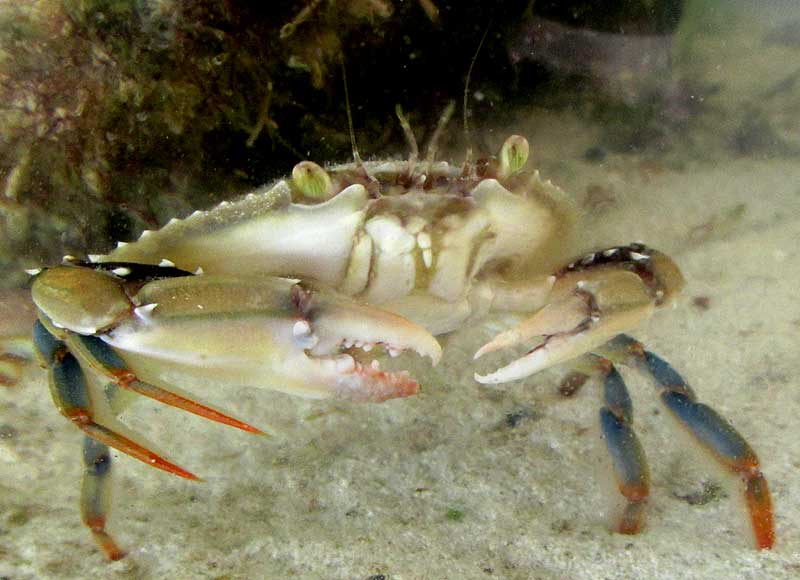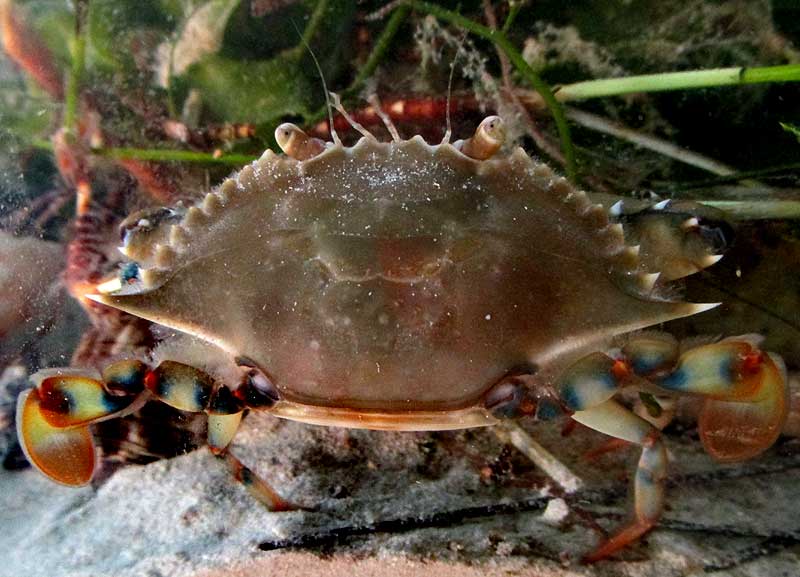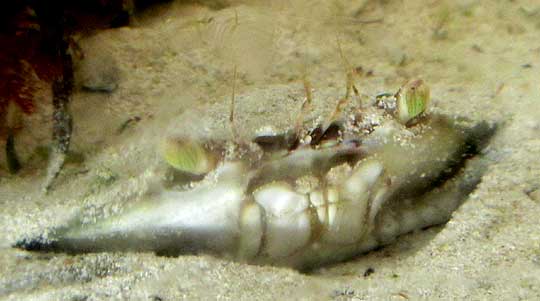Excerpts from Jim Conrad's
Naturalist Newsletter

from the March 22, 2015 Newsletter issued from Río Lagartos, on the Yucatan Peninsula's northern coast (~N21.60°, ~W88.16°), Yucatán state, MÉXICO
ORNATE BLUE CRAB
I'm such a landlubber that when I first came to the Yucatan I thought that all crabs lived on sandy beaches. Then one day on a boat ride to Cozumel Island not only was I astonished by flying fish popping from the surrounding water but also by pale, ghostly crabs that sometimes surfaced, paddled furiously alongside us, then sank back below. For a long time I've wanted a close look at one of those aquatic crabs with paddles on their legs, so when some caught in the estuary turned up in the aquarium I was tickled to meet them. Above, you can see one seeming to examine me through the aquarium's glass walls.
This view doesn't show paddles but it does afford a good look at his stalked, greenish eyes and, between the eyes, two pairs of antennae, which constantly quivered and jerked and waved about as the water was being felt, smelled and tasted with an exquisite sensitivity I couldn't imagine. As if sensing my interest in seeing the paddles, the crab suddenly turned around, providing the view shown below:

The blue, white and orangish paddles reveal themselves as flat segments of the crab's "swimming legs." If you look up crab swimming-legs on the Internet you find that each segment has its own name. The segment attaching to the body is the coxa, and the coxa attaches to the basi-ischium, and then comes the merus, the carpus, the propodus, and finally the dactyl. Even the spines along the sides of the top of the shell, or carapace, have a name -- anterolateral teeth -- and bear official numbers, with the big, white-tipped ones at the bottom being the lateral spines.
This is the Ornate Blue Crab, CALLINECTES ORNATUS. It's similar to the Atlantic Blue Crab, Callinectes sapidus, famous among crab eaters along the US eastern coast, but the Ornate Blue is slightly different in terms of tooth arrangement along the carapace sides, and other obscure details. Our Ornate Blue occurs from North Carolina south through the Gulf of Mexico and Caribbean to Rio Grande de Sul, Brazil. It lives at depths of up to 250ft (75m) on sand and mud bottoms. Though often it's found in river mouths, more commonly it turns up offshore. Juveniles usually occur in shallower habitats.
Ornate Blue Crabs often feed on decaying matter, but they can hunt and kill as well. The species may dig into mud and sand looking for prey such as clams, other crabs, algae, polychaetes, echinoderms, etc. This flexibility of behavior is one reason the species is so successful and common over its distribution. In the aquarium, our Ornate Blues often bury themselves almost completely, keeping their stalked eyes above the sand. Below, you can see one peeping from his sand cover:

Often Ornate Blues are accidentally caught during commercial fishing for Atlantic Blue Crab, but so far they are not considered to be threatened as a species.